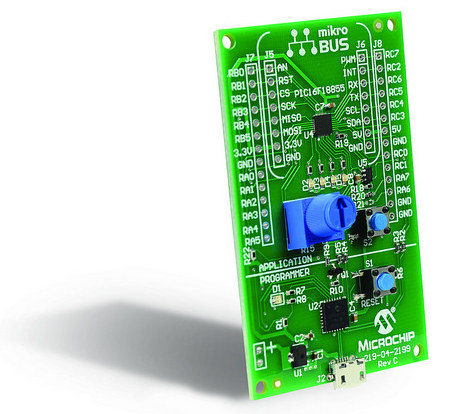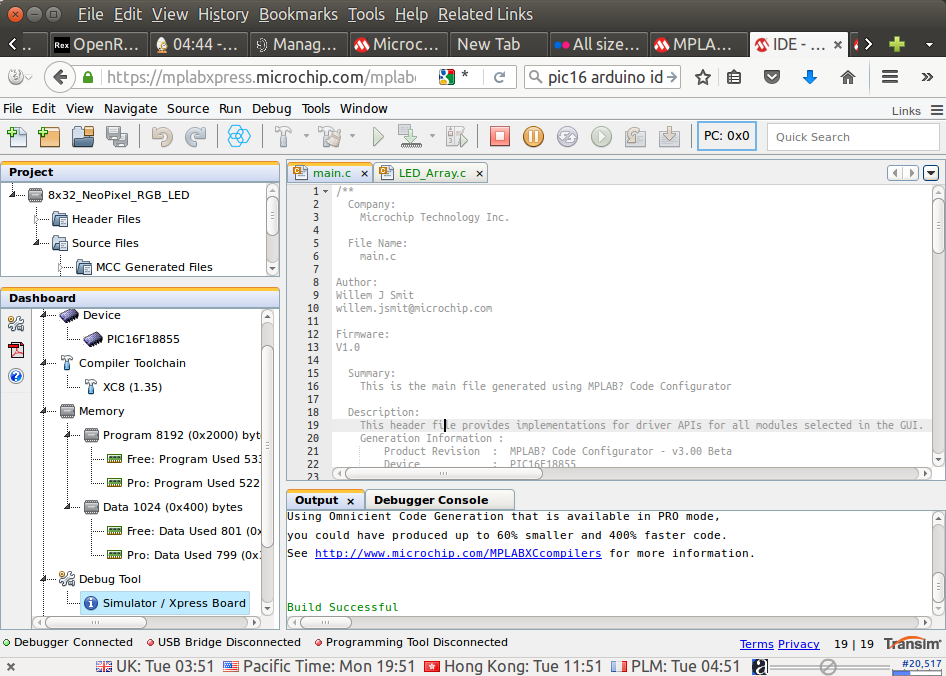Microchip has just launched MPLAB Xpress online IDE with some of the most used features of the company’s MPLAB X IDE, as well as a free – in limited quantities – MPLAB Xpress evaluation board based on a PIC16 micro-controller.
 Let’s get through the development board specifications first:
Let’s get through the development board specifications first:
- MCU – Microchip PIC16F18855 MCU with 14KB flash, 1KB SRAM, 256 bytes EEPROM
- USB – micro USB port for power and programming
- Expansion Headers
- Unpopulated mikroBUS header supporting one of 180 Click boards
- Unpopulated 2x 14-pin header with GPIOs, I2C, SPI, UART, ADC, etc…
- Misc – Reset button, user button, potentiometer
- Dimensions – N/A

Playing with hardware is always more fun, but if you just want to evaluation the online IDE, you don’t even need the board. Visit MPLAB Xpress Code Examples page, load one of the example, possibly log-in if you want to save changes to the 10GB free online storage that comes with a myMicrochip account, and you’ll be able to run and debug the sample in the simulator. Since the IDE is web based you don’t need to install any software, and it works on Windows, Linux, and Mac OS X.
You may want to go through the tutorial to learn more about the IDE, or visit the forums for support. MPLAB Xpress currently supports three hardware platforms: MPLAB Express board mentioned above, Curiosity board, and PICkit 3 in-circuit debugger/programmer that supports over 1,000 PIC MCUs.
If you’d like to apply for one of the 2,000 free MPLAB Express board, you can do so @ http://www.microchip.com/Xpress-021516a, or visit Microchip booth at Embedded World 2016. On a related note, Olimex will also give away 1,000 PIC32 boards at the event.

Jean-Luc started CNX Software in 2010 as a part-time endeavor, before quitting his job as a software engineering manager, and starting to write daily news, and reviews full time later in 2011.
Support CNX Software! Donate via cryptocurrencies, become a Patron on Patreon, or purchase goods on Amazon or Aliexpress





No need of having a working GCC, it is now hosted in the dark cloud.
I don’t mind having a cloud development option so long as we have decent offline development tools as well. While the MPLABX is very good the main issue that I have with Microchip is their refusal to offer their GCC based toolchains for the PIC24/dsPIC/PIC32 families for free without crippling optimization.
]
Also the PIC16/PIC18 families are not exciting to use at all. They’re old,archaic and were originally intended to be easy to code for in assembly in the 80s. Those days of coding in assembly are over. STM32F030’s are basically replacing the PIC16/18 in many use cases. The ST parts are just as cheap and way more capable while still easy to use. Offline development tools are available for free via ST’s workbench. ST-LINK debuggers are very cheap and found on every Nucleo dev board, and ST-Nucleo boards with debugger, programmer and USB2Serial port cost $12. Mbed cloud-based (and offline based) tools are also available.
@Hussam
I like using the newer 16F and 18F series of chips. They’re designed to be used with a compiler, not hand written assembly like the older 16F chips were. I specifically like them because, unlike the STM32 chips, they are available in a breadboard friendly DIP package. Several of them also have a built in USB module, making it possible to create a USB project on a piece of strip board without a second dedicated USB-to-serial communication chip. Some (like the 18F25K50) can communicate with a USB host PC at Full Speed without needing an external crystal, thanks to its active clock tuning module.
@jimg
The stm32f042/stm32f030 parts come in 20-pin SSOP packages and easy to solder 0.8mm pitch 32-lqfp. You can get a ssop to dip or lqfp to dip adapter and easily solder these chips to it to access them on a breadboard. Alternatively you can also use one of the mini Nucleo-32 boards that are Arduino Nano sized, come with programmer, debugger & USB 2 serial. They fit into a breadboard with ease and cost only $12.
Last time I used the Microchip parts was maybe in 2008 (PIC32s). I remember using the eprom based PIC16C74A and its eeprom equivalents in the late 90s early 2000’s. The newer versions of these chips might very well have amazing peripherals and higher clock rates. This doesn’t change the fact that the CPU core is still the same 40 year old core running at a higher clock with perhaps some minor add-ons. If the CPU core of the PIC16F is truly significantly improved over the one from the 90s, why haven’t we heard anything about it in marketing?
Microchip’s mantra is ‘who cares about the CPU core so long as you get the peripherals that you need’. Some might agree with that. I personally disagree. I think that while peripherals are important, the core is at least just as important. Especially when one wants to optimize power consumption, improve code density or reduce interrupt latency e.t.c.
Also as an educator, I feel I would be doing my students a disservice if I taught them PIC16/PIC18s microcontrollers with outdated cores. I think they would benefit more by learning Embedded systems with more recent and better architectures such as the Cortex-M0/M4 based micros. But that’s just my opinion.
I’ve just received my free board, that was reasonably fast…
The board is now available @ http://info.microchip.com/Q05E0bD0U93C60j0U0019k0
$10 + free shipping with coupon EXPINTRO16 valid until August 30, 2016.